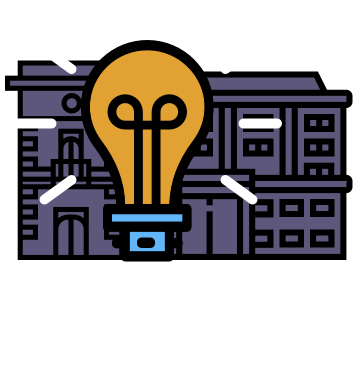What can you be doing in your region to prevent evictions & reduce the instability that they might cause?
This Eviction Innovation Blueprint reviews the 4 key areas that policymakers & service providers can prioritize. What are the promising practices you should be implementing in your region? This Blueprint provides an overview and specific examples to prevent & reduce the harm of evictions.
The 4 Key Areas of Eviction Innovations
- Upstream: Prevention of disputes from becoming lawsuits or forced moves
- Midstream: Ensuring people have full access to the justice system, and diverting lawsuits away from judgments & forced moves
- Downstream:
- Strategic Infrastructure, Upstream Prevention, Access to Justice, and Mitigating After-Effects.
One key first step is to establish a local task force that works on eviction prevention and housing stability. Across the country, these local groups have taken the lead in pioneering the practices listed below. Your local coalition can identify the key opportunities and next steps to addressing your eviction crisis.
Blueprint for Eviction Innovation

Ongoing Infrastructure: Do you have Strategic Setups for Eviction Prevention?
- A Task Force from across agencies, courts, local government, legal services, and advocacy groups
- A Data Exchange to ensure the groups have intelligent coordination
- Funders to support new programs and policies
- A Central Resource Hub online and in person, for tenants, landlords, & other community members to find help on rentals & evictions
- Government Attorneys & city inspectors that enforce laws on fair housing, consumer protection of tenants, and emergency rental agreements

Upstream: Do you have Early Prevention of Evictions (both formal & informal)?
- Know Your Rights materials, hotlines, sessions, outreach, and tech tools so people can learn key legal information to protect themselves
- Renter and Landlord Incentive Programs to train them in landlord-tenant law, encourage good relationships
- Rental Registries & Oversight to ensure landlords are following the law, and provide communication channels to tenants and landlords
- Early Conflict Resolution with mediators and settlement agreements, before the conflict spirals
- Limit on Eviction Lawsuits by preventing landlords from suing tenants during emergencies, when they have code violations, or cannot show just cause

Midstream: Do you provide Access to Justice for People in Eviction Lawsuits?
- Right to Counsel legislation and funding to get free lawyers to people facing eviction
- Due Process Reforms in eviction court procedure, that provide sufficient time, notice, and support that people can have a fair day in court
- Eviction Diversion Programs that provide rent assistance, mediation, social services, and other holistic services to prevent eviction judgments & resolve underlying problems
- Non-Lawyer Advocates to represent people in court when there are not enough lawyers
- Community Navigators to spot people’s legal issues, teach them about their rights, help them follow the process, and deal with stress and emotions
- Collaborative Courtrooms in which judges & clerks actively engage with the litigants, connect them with services, and oversee settlements

Downstream: Do you stop the harmful after-effects of evictions?
- Post-Judgment Support with easy motions to set aside default judgments & motions to stay the eviction, and legal aid to explore the next steps
- Eviction Record masking so others (like credit providers or background check companies) can’t see the lawsuit or order on people’s records
- Changing eviction record policies, prohibiting reporting for several months, or reducing the 7-year scarlet ‘E’ timeframe
- Stable Transition support with caseworkers to support the family, connect them with new housing and financial coaching, deal with school transition, store home goods, and get an address

Area 1: Strategic Infrastructure for Eviction Prevention
Does your region have the partnership, data, and oversight of your eviction prevention landscape? Make sure you are following best practices, with these key steps.
- A Task Force from across agencies, courts, local government, legal services, and advocacy groups
- A Data Exchange to ensure the groups have intelligent coordination
- A Central Resource Hub online and in person, for tenants, landlords, & other community members to find help on rentals & evictions
- Government Enforcement of housing laws, with attorneys & city inspectors that enforce laws on fair housing, consumer protection of tenants, and emergency rental agreements
1a.
Task Force for eviction prevention
Every region should have an Eviction Prevention Task Force. This can be a working group of people from different agencies and community groups working together, to create a holistic eviction prevention system.
For example, see Pittsburgh and Allegheny County’s task force that meets regularly to coordinate an overall agenda and specific interventions.
This task force can also coordinate funding sources to support the most promising interventions.
1b.
Data Exchange
Establish a Data Exchange in order to have standard, coordinated ways to know what is happening to landlords & tenants at the various stages of eviction.
Data is essential to understanding the state of your eviction system, and developing more intelligent services that can increase people’s participation in the system, and the service providers’ work. Key data-holders, including courts, legal aid agencies, social service nonprofits, rental assistance providers, and homelessness services can establish data exchanges.
These exchanges allow for ethical, protective sharing of data among providers. Groups can set up the infrastructure and then avoid one-off negotiations.
The shared data can help agencies:
- verify people’s eligibility for services,
- see if a certain case should be on a fast track or delayed,
- know whether a person has applied for services and is waiting for an outcome
- know what past services a person has receiving, and
- do proactive outreach to people about services that might benefit them.
In some cases, the data exchanges can also be public-facing data dashboards (like this one in Allegheny County, PA) and trackers of evictions (like this one in Milwaukee).
1c.
Central Resource Hub
A region should have one, central hub where all resources for landlords & tenants are available. This should be a website at the minimum. It might also include an in-person office, phone hotline, or texting hotline.
The hub should have :
- an explanation of the local eviction system, with timelines and key rights
- an overview of the services available for a person in specific scenarios in the eviction space
- step-by-step guides for how to do common tasks in dealing with eviction notices, lawsuits, and orders
- FAQs on common scenarios that people are dealing with
The one central hub can then be the place where there is reliable, up-to-date information. It lets groups – – like courts, social service agencies, housing navigators, search engines, or others — direct people to this one key place.
See the Rental Housing Resource Center in Milwaukee, that has both a digital and in-person center.
1d.
Governement Enforcement of Housing Laws
The government should have dedicated resources and trained attorneys and inspectors that are enforcing key housing laws.
This includes enforcement around:
- habitable living conditions, including landlord upkeep of their rental properties,
- landlords abiding by due process, including around giving proper notice,
- landlords abiding by agreements they have made, including not suing for eviction after receiving rental assistance,
- tracking of repeat offenses, hotspots of violations, or other trends that the data can reveal.
See Minnesota’s Attorney General’s office and projects in NYC & DC to track problems.

Area 2: Upstream Strategies to Prevent Evictions
Have you invested in preventative strategies that can prevent tenant-landlord relationships from turning into lawsuits and forced moves?
- Know Your Rights materials, hotlines, sessions, outreach, and tech tools so people can learn key legal information to protect themselves
- Renter and Landlord Incentive Programs to train them in landlord-tenant law, encourage good relationships
- Rental Registries & Oversight to ensure landlords are following the law, and provide communication channels between service agencies & tenants and landlords
- Early Conflict Resolution with mediators and settlement agreements, before the conflict spirals
- Limit on Eviction Lawsuits by preventing landlords from suing tenants during emergencies, when they have code violations, or cannot show just cause
2a
Know Your Rights Outreach
…
Eviction Prevention: Access to Justice During the Eviction Lawsuit
Right to Counsel
Your community can benefit from having Right to Counsel as a funded mandate, to ensure every tenant facing eviction has a free lawyer to represent them.
In some regions, this has been done through a city council mandate, a program of the mayor’s office, or otherwise. It typically involves
- A new policy or law that establishes Right to Counsel in eviction cases,
- A funding source to pay for the lawyers, outreach, and administration of the program
- A network of legal aid organizaitons that will provide the services
Right to Counsel has been established in the states of Washington, Maryland, and Connecticut, as well as the cities of New York, San Francisco, Newark, Cleveland, Philadelphia, Boulder, Baltimore, Seattle, Louisville, Denver, Toledo, Minneapolis, and Kansas City.
See more of Right to Counsel for tenants at the National Coalition for a Civil Right to Counsel.
Eviction Court Reforms
Local courts that hold eviction trials can improve how accessible they are to the tenants and landlords who use them (especially if they do not have lawyers).
This can be through small changes to their procedures, paperwork, courtroom setup, and coordination with other service providers. Some of these reforms include:
- Setting up data exchanges with city agencies that provide rent assistance, to ensure that tenants facing eviction are fast-tracked through the program and that landlords who have accepted assistance are not suing their tenant in violation of the program. See data exchanges in Allegheny County, Pennsylvania; Shelby County, Tennessee, and Philadelphia, Pennsylvania.
- Providing an official lawsuit Summons and Complaint that are easy-to-understand and with clear next steps for finding legal and rent assistance. See Cincinnati’s example of a well-designed eviction court summons.
- Co-locating emergency rent, housing navigators, homeless services, and social work navigators in the courthouse. This can ensure tenants and landlords have full access to services that can help them reach good outcomes. See Columbus’s example of co-located social workers.
Non-Lawyer Advocates
Non-lawyer advocates, like Qualified Tenant Advocates or Justice Advocates, can provide help to tenants in the court process.
Tenants benefit from having representaiton in their court hearings. Often there are not enough housing defense attorneys to provide representation to all tenants sued for eviction.
See more about Delaware’s new Qualified Tenant Advocate program.
Eviction Diversion & Mandatory Mediation Programs
Eviction Diversion Programs can help divert disputes between tenants and landlords to agreeable out-of-court settlements. They can also bring holistic services, including rental assistance, social lservices, legal services, and mediation to the parties.
The diversion programs can apply before a case has formally been filed. This is called Mandatory Pre-Filing Diversion or Mediation. The landlord cannot file a lawsuit until they have gone through the progam to try ot reach a settlement. The benefit is that tenants will not have an eviction case on their record. It can also spare both sides legal costs. See more about Philadelphia’s pre-filing mediation requirement here.
Mediation can also be mandatory after the lawsuit, like with a Mandatory Settlement Conference (in which a judge strongly pushes for an out-of-court settlement), or through a requirement that a landlord and tenant must go to mediation before they can have a trial.
Read more about Michigan’s mandatory settlement conference here. And read about Pittsburgh’s eviction mediation program, and Bloomington, Indiana’s pro bono mediation program.
See our page on Eviction Diversion Programs here.
Community Navigators
Community Navigators can help get tenants learn their rights, connect with services, and participate in the process.
Navigators can play roles before, during, and after a formal eviction action. They can help a person find rent relief or mediation before a lawsuit. If the tenant has been sued, they can prep the tenant for court, help them avoid a default, and get their evidence in order. After court, they can help them with followup, moving plans, additional services, and cleaning their eviction record.
See more about the NAACP’s South Carolina Housing Navigator program here.
In Louisville, community navigators are taking a strong role in preventing defaults. Once a tenant is sued, the community navigators
- get notified of the court record,
- find the address and phone number of the tenant, and
- visit the tenant to let them know about their rights and how to protect themselves at court.
Explore the Bay Area, California Legal Link program for navigators called Legal First Aid. It trains social service workers in legal navigation.
